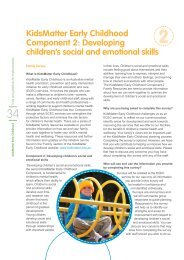Component 2: Developing children's social and ... - KidsMatter
Component 2: Developing children's social and ... - KidsMatter
Component 2: Developing children's social and ... - KidsMatter
You also want an ePaper? Increase the reach of your titles
YUMPU automatically turns print PDFs into web optimized ePapers that Google loves.
Why <strong>social</strong> <strong>and</strong> emotional skills are importantIt is widely accepted that the development of<strong>social</strong> <strong>and</strong> emotional skills in early childhoodbenefits all aspects of children’s lifelong learning<strong>and</strong> development. Children’s developing <strong>social</strong><strong>and</strong> emotional skills in the early years form thefoundation upon which subsequent learning<strong>and</strong> development depends, including life skillssuch as thinking, planning <strong>and</strong> decision making.Notably, <strong>social</strong> <strong>and</strong> emotional skills are a protectivefactor for present <strong>and</strong> future mental health <strong>and</strong> wellbeing.Children who have developmentally appropriate<strong>social</strong> <strong>and</strong> emotional skills are more likely tohave better outcomes than children who are lessskilled. For example, children who regulate theiremotions are empathic, relate to peers effectively,respect the rights of others, <strong>and</strong> perform better atschool. Children who are less skilled tend to havemore negative experiences with peers <strong>and</strong> adults.This can have lifelong impacts. For example,some children may have limited <strong>social</strong> skills to join ingroup play, <strong>and</strong> that can lead to feelings of isolationor rejection <strong>and</strong> undermine self-confidence.As with other areas of learning, children develop<strong>social</strong>ly <strong>and</strong> emotionally at different paces. Childrenhave different temperaments, opportunities <strong>and</strong>experiences, <strong>and</strong> a variety of risk <strong>and</strong> protectivefactors in their lives. Children continue to develop<strong>and</strong> learn these skills over time. High-quality care,that purposefully fosters children’s developing <strong>social</strong><strong>and</strong> emotional skills through children’s positiverelationships with staff, has been shown to benefitchildren’s mental health <strong>and</strong> wellbeing, learning,motivation to achieve <strong>and</strong> cooperate, <strong>and</strong> thedevelopment of values.<strong>Developing</strong> <strong>social</strong> <strong>and</strong> emotional skills in<strong>KidsMatter</strong> Early Childhood<strong>Component</strong> 2 focuses on the following threeareas which contribute to developing <strong>social</strong><strong>and</strong> emotional skills:Relationships between children <strong>and</strong> educatorsThis involves developing warm, responsive<strong>and</strong> trusting relationships between children <strong>and</strong>educators. This provides a foundation for children tolearn <strong>and</strong> develop <strong>social</strong> <strong>and</strong> emotional skills <strong>and</strong> isa protective factor for mental health.Children’s <strong>social</strong> <strong>and</strong> emotional skilldevelopmentWhen educators have an underst<strong>and</strong>ing of <strong>social</strong><strong>and</strong> emotional development, this can assist them tosupport children’s <strong>social</strong> <strong>and</strong> emotional developmentthrough intentional teaching <strong>and</strong> making the most ofeveryday opportunities <strong>and</strong> interaction.Staff development <strong>and</strong> supportEducators are best able to form positiverelationships <strong>and</strong> support <strong>social</strong> <strong>and</strong> emotionaldevelopment when they participate in regular staffdevelopment <strong>and</strong> support. This can occur througha range of different types of development includingmentoring <strong>and</strong> reflective practice.Social <strong>and</strong> emotional learning is linked togood mental health <strong>and</strong> better life outcomes.Children’s <strong>social</strong> <strong>and</strong> emotional developmentcan be nurtured <strong>and</strong> enhanced throughrelationships with the adults in their lives.What <strong>social</strong> <strong>and</strong> emotional skills develop inearly childhood?Early childhood is the period of greatest growth<strong>and</strong> development, including children’s <strong>social</strong> <strong>and</strong>emotional skills. Early childhood can be dividedinto three developmental periods that overlap:■■babies (birth to around 18 months)■■toddlers (around 18 months to three years)■■preschoolers (around three to five years).Children are born <strong>social</strong> beings with a preferencefor <strong>social</strong> interaction <strong>and</strong> the capacity to experience<strong>and</strong> express emotions, explore their world,develop <strong>and</strong> learn. In the first 18 months of a child’slife, this development <strong>and</strong> learning occurs at anastounding rate due to the rapid growth of the baby’sbrain. Babies progress from being highly dependentnewborns to walking, self-assertive individuals withgrowing language skills.Children’s <strong>social</strong> <strong>and</strong> emotional skills are constantlydeveloping at different ages <strong>and</strong> stages. Skills buildupon earlier skills, are often inter-related <strong>and</strong> affectother areas of development such as language,thinking, planning <strong>and</strong> decision making. Children’sdevelopment of <strong>social</strong> <strong>and</strong> emotional skills is alsodependent upon development in these other areas<strong>and</strong> associated brain growth. Babies <strong>and</strong> toddlersengage in more concrete thinking based on whatthey can see. Preschoolers begin to have moreconscious control <strong>and</strong> use abstract thinking, suchas underst<strong>and</strong>ing of the past <strong>and</strong> the future to guidetheir thoughts, feelings <strong>and</strong> actions. However, itis useful to remember that these skills are justbeginning in preschoolers <strong>and</strong> that they may find itdifficult to make responsible decisions <strong>and</strong> ‘do theright thing’ on their own.<strong>KidsMatter</strong> Early Childhood A framework for improving children’s mental health <strong>and</strong> wellbeing23
<strong>KidsMatter</strong> Early Childhood A framework for improving children’s mental health <strong>and</strong> wellbeing24<strong>KidsMatter</strong> Early Childhood has organised children’s<strong>social</strong> <strong>and</strong> emotional skills into three core areas thatare considered essential for children’s developmentof good mental health <strong>and</strong> wellbeing. These providea useful way of conceptualising, organising <strong>and</strong>planning <strong>social</strong> <strong>and</strong> emotional development acrossthe early childhood period. The core <strong>KidsMatter</strong>Early Childhood <strong>social</strong> <strong>and</strong> emotional skill areas are:Sense of self: Children’s developing capacity to feelpositive about themselves <strong>and</strong> their capabilities.Social skills: Children’s developing capacity tointeract successfully with others.Emotional skills: Children’s developing capacityto recognise, express <strong>and</strong> regulate feelings.SocialskillsSense of selfEmotionalskillsAs this diagram shows, these areas overlap <strong>and</strong>some skills may fall into more than one area.Children may also sometimes demonstrate differentskill levels at different times or in different situations.For example, a child may demonstrate unexpectedpatterns of behaviour <strong>and</strong> operate at a youngerlevel at times of increased stress, such as duringtransition <strong>and</strong> change. These three skill areas arenow described in more detail for babies, toddlers<strong>and</strong> preschoolers.Sense of selfChildren’s sense of self includes recognising thatthey are individual beings separate from others<strong>and</strong> have their own thoughts, feelings, wants <strong>and</strong>goals. Children become more independent <strong>and</strong>autonomous as they grow <strong>and</strong> develop. Children arepredisposed to interact with others to createexperiences that enable them to feel good aboutwho they are, to see themselves as capable, to buildself-confidence <strong>and</strong> to continue to be motivated tolearn <strong>and</strong> engage in new experiences.For children to develop their sense of self, it isinvaluable for them to have opportunities to makechoices, explore, develop <strong>and</strong> practise new skills.Skilled caregivers act as a secure base from whichchildren can venture <strong>and</strong> explore but to whom theycan also return for security, comfort <strong>and</strong> reassurancewhen needed.Supporting children’s developing sense of self links<strong>KidsMatter</strong> Early Childhood with the underlyingPrinciples that support the Learning Outcomes inthe Early Years Learning Framework. For example,the Principles of secure, respectful <strong>and</strong> reciprocalrelationships assist children to feel safe, secure <strong>and</strong>supported. When children trust their environment,they are able to learn about themselves <strong>and</strong> howthey relate to their world, feel safe to explore <strong>and</strong>develop self-confidence. This is one way thateducators can integrate the Early Years LearningFramework with <strong>Component</strong> 2 of <strong>KidsMatter</strong> EarlyChildhood. Connections between the Early YearsLearning Framework <strong>and</strong> the National QualitySt<strong>and</strong>ard related to <strong>Component</strong> 2 are exploredat the end of this section.
BabiesIn their first few months, babies actively interact with others but do not have the underst<strong>and</strong>ing that they existas a separate person from their caregivers until they are around nine months old. At this stage, babies maybegin to experience separation anxiety when they are apart from their caregivers as they are adjusting to theirnew level of underst<strong>and</strong>ing <strong>and</strong> resulting feelings of fear that perhaps their caregiver may not return. At thisearly stage of developing a first sense of self, babies think that others have the same thoughts <strong>and</strong> feelingsas they do.Children between one <strong>and</strong> two years:■■begin to distinguish ‘me’ from ‘not me’■■begin to have their own thoughts, desires <strong>and</strong> feelings■■practise their skills <strong>and</strong> begin to see themselves as capable■■use responses from others to build a positive sense of self■■may experience increased separation anxiety.<strong>KidsMatter</strong> Early Childhood A framework for improving children’s mental health <strong>and</strong> wellbeing25From birth, Jamie’s parents responded to her needsquickly, smiled at her <strong>and</strong> held her close when shewas upset.This helped Jamie feel secure <strong>and</strong> develop a sense of trustin the world. As she grew, Jamie gradually began toexperiment with making things happen through her own actions.When she smiled at her mother, her mother smiled back at her.She liked to reach out <strong>and</strong> touch the bumblebee on her play mat<strong>and</strong> make it move with her h<strong>and</strong> over <strong>and</strong> over again. By the ageof one, her parents discovered that Jamie responded differently tosituations compared to her older brother, <strong>and</strong> she was developingher own individuality. By 18 months, Jamie also began to assert herindependence by often refusing to do things <strong>and</strong> shaking her headto things she did not like. She displayed curiosity about people <strong>and</strong>her surroundings by pointing out things to her parents that she foundinteresting, such as dogs or birds when she was playing in the park.Jamie showed she felt confident in her ability to do some things,like taking the lid off a cup, without any help.
<strong>KidsMatter</strong> Early Childhood A framework for improving children’s mental health <strong>and</strong> wellbeing32PreschoolersChildren become more independent in the preschoolperiod. Supported by their increased language,thinking, planning <strong>and</strong> organising capacities,their emotional skills also become more advanced.Preschoolers’ emotional skills include the developingability to:■■wait <strong>and</strong> show patience for things they want■■manage a range of feelings such as anxiety,sadness <strong>and</strong> frustration■■become more tuned in to the feelings of others■■use language to express how they are feeling<strong>and</strong> to acknowledge the feelings of others■■make judgements about themselves <strong>and</strong> feelpride <strong>and</strong> shame.At the age of four, Edin can now expressmore complex emotions depending onthe situation.He loves to play outside <strong>and</strong> often laughs whenhe is running around the garden. He hid hisface in his h<strong>and</strong>s when he didn’t quite make it tothe toilet in time. He can use words to describehis feelings, telling his mother how excited hewas when his uncle was coming over for a visit.Edin can wait for things sometimes, like whenhis father takes him to the supermarket <strong>and</strong>buys him a treat for after dinner. Edin has a fewdifferent ways to make himself feel better whenhe feels sad or worried, including hugging hisfavourite teddy <strong>and</strong> seeking out his parents fora cuddle.
Social <strong>and</strong> emotional skills continue to develop as children grow<strong>and</strong> interact with adults <strong>and</strong> other children. Development remainsinfluenced by children’s early experiences. This highlights theimportance of quality experiences in the early years.Getting ready for school‘We carry our infant story inside<strong>and</strong> live it in our close relationships.’– Gerhardt, 2004.Social <strong>and</strong> emotional skills of children who manage well inschool include:■■having positive attitudes about themselves <strong>and</strong> their abilities■■being able to underst<strong>and</strong> their feelings <strong>and</strong> those of others■■regulating their feelings <strong>and</strong> behaviours■■getting along with peers <strong>and</strong> adults■■cooperating, following directions, <strong>and</strong> concentrating where necessary■■being motivated to solve problems with others■■becoming respectful <strong>and</strong> contributing members of the community.Children are primed to learn core <strong>social</strong> <strong>and</strong> emotional skills.Core <strong>social</strong> <strong>and</strong> emotional skills enable children to:<strong>KidsMatter</strong> Early Childhood A framework for improving children’s mental health <strong>and</strong> wellbeing33■■feel good about themselves■■recognise <strong>and</strong> manage their feelings■■interact successfully with others.
<strong>KidsMatter</strong> Early Childhood A framework for improving children’s mental health <strong>and</strong> wellbeing34The four following tables provide an overview of the three core areas of <strong>social</strong> <strong>and</strong> emotionalskill development in early childhood, <strong>and</strong> provide examples of these skills for babies,toddlers <strong>and</strong> preschoolers.Overview of core <strong>social</strong> <strong>and</strong> emotional skills in early childhoodSense of selfIn early childhood, children areforming their sense of self inrelation to others <strong>and</strong> developingskills such as:Social skillsSocial skills refer to children’sdeveloping capacity to interactsuccessfully with others <strong>and</strong>include:Emotional skillsEmotional skills refer to children’sdeveloping capacity to recognise<strong>and</strong> regulate feelings, <strong>and</strong> include:■■■■■■■■■■■■■■■■■■■■■■■■being able to recognise their own thoughts, desires <strong>and</strong> feelingsfeeling good about themselves <strong>and</strong> their abilitiesseeing themselves as capable individualsbecoming independentbeing curious <strong>and</strong> motivated to solve problems <strong>and</strong> seeing themselvesas ‘doers’ with self-initiated goals.experiencing enjoyable, pleasurable interactions <strong>and</strong> relationshipspro-<strong>social</strong> behaviours such as learning to take turns, cooperating,appreciating diversity, communicating effectively, <strong>and</strong> respondingappropriately to people <strong>and</strong> situationsdeveloping their relationship skills by widening their <strong>social</strong> network,developing preferences <strong>and</strong> forming friendshipsbeginning to negotiate solutions to conflicts using words to describetheir feelings <strong>and</strong> listening to others.developing their ability to recognise, express <strong>and</strong> underst<strong>and</strong> theirown feelingsmoving from regulating their emotions in partnership with others, toself-regulating their feelings <strong>and</strong> behaviours, including being able tomanage negative feelings such as anxiety, sadness <strong>and</strong> frustrationlearning that others have feelings too■■developing their ability to recognise <strong>and</strong> label others’ feelings <strong>and</strong>responding accordingly.
Babies (birth to around 18 months)Sense of self Social skills Emotional skills■■■■■■■■Children become able todistinguish themselvesfrom others.Children increasingly engagein goal-directed behaviour.Children become aware oftheir relationships with others.Children are becoming awareof their growing skills.Some typical <strong>social</strong> <strong>and</strong> emotional skills■■■■■■■■■■■■■■■■■■■■■■■■■■■■Children are born tuned in to<strong>social</strong> stimuli.Initially they show a preferencefor communication with theirprimary caregiver.Later, children becomeincreasingly attuned to thewider <strong>social</strong> world aroundthem <strong>and</strong> enjoy <strong>social</strong>interaction with more people.Expresses emotions such as happiness, anger, contentment, interest <strong>and</strong> surpriseSocial smiles <strong>and</strong> vocalisations (for example, laughter)Responds to their nameResponds preferentially to primary caregiversEngages in self-soothing behaviourLifts arms up when wanting to be picked upShows wariness, <strong>and</strong> sometimes fear of strangersEnjoys a game of peek-a-booShows awareness of others’ emotional reactions by reacting themselvesShows increasing eye contactShows resistance when separated from close adults■■■■■■Children display <strong>and</strong> appreciateprimary emotions.Children use simple methodsto comfort themselves.Children initially rely oncaregivers for emotionalsupport <strong>and</strong> regulation,becoming more independentas they grow <strong>and</strong> develop.<strong>KidsMatter</strong> Early Childhood A framework for improving children’s mental health <strong>and</strong> wellbeing35■■■■■■■■■■■■Uses parents or carers as a secure base from which to exploreHolds objects up to othersLooks at the reactions of their caregivers to gauge how to react when faced with new situations (<strong>social</strong> referencing)Imitates othersPlays independentlyBecomes excited when greeted by a familiar adult who loves to play with them.Note: This table is illustrative <strong>and</strong> is not exhaustive. Ages at which skills appear are approximate <strong>and</strong> skills may emerge earlier or later for individual children. Some skills fall intomore than one area.
<strong>KidsMatter</strong> Early Childhood A framework for improving children’s mental health <strong>and</strong> wellbeing36Toddlers (around 18 months to three years)Sense of self Social skills Emotional skills■■■■■■■■Children are becoming awareof characteristics of themselves(for example, body parts).Children’s sense of self isconcrete <strong>and</strong> based on thingsthat they can see <strong>and</strong> do.Children can express <strong>and</strong> assertthemselves.Children can anticipatebehaviour of others based ontheir past experiences with them.Some typical <strong>social</strong> <strong>and</strong> emotional skills■■■■■■■■■■■■■■■■■■Says ‘no’ to indicate preferencesBecomes more able to cooperate with directionsRecognises self in the mirror■■■■■■Children can identify others byname, especially close friends<strong>and</strong> relatives.Children show increased interestin interacting with peers <strong>and</strong>other adults.Children are learning appropriateways to behave in differentsituations.■■■■■■Children display more complexemotions, <strong>and</strong> use emotionsintentionally.Children show awarenessof more complex emotionsof others.Children are becoming moreskilled at regulating their ownemotions.Explores <strong>and</strong> makes sense of their physical <strong>and</strong> <strong>social</strong> worlds, such as by dropping or throwing objects <strong>and</strong>organising their caregivers’ responses to their behaviourEngages in ‘helping behaviours’, such as gardening, shopping <strong>and</strong> cleaningExpresses more complex emotions, such as pride, jealousy, embarrassment <strong>and</strong> guiltPlays alongside other children (‘parallel play’)Demonstrates empathy towards others through affectionate pats <strong>and</strong> hugsCommunicates the emotions of others (for example, says ‘Mum sad’)■■■■■■Can say their own nameUses personal pronouns (for example, I, me, she, he, you) during <strong>social</strong> interactionsIdentifies friends <strong>and</strong> family by name.Note: This table is illustrative <strong>and</strong> is not exhaustive. Ages at which skills appear are approximate <strong>and</strong> skills may emerge earlier or later for individual children. Some skills fall intomore than one area.
Preschoolers (around three to five years)Sense of self Social skills Emotional skills■■■■■■■■Children become aware of thegroups that people belong to.Children’s sense of self includesmore abstract aspects, such aslikes <strong>and</strong> dislikes.Children can identify theirfeelings <strong>and</strong> needs.Children continue to developtheir self-concept.Some typical <strong>social</strong> <strong>and</strong> emotional skills■■■■■■■■■■■■■■■■■■■■■■■■Children display more voluntarycontrol over behaviour <strong>and</strong>emotions <strong>and</strong> engage in morecomplex play.Children begin to developlonger-lasting friendships.■■■■Children are learning to express,label <strong>and</strong> regulate a wider rangeof emotions.Children increase theirunderst<strong>and</strong>ing of the feelings ofothers <strong>and</strong> use this when forming<strong>and</strong> developing friendships.Displays empathy towards others <strong>and</strong> may use language (for example, comforts a peer with a hug or favourite toy<strong>and</strong> words, or alerts caregiver to help)SharesWaits <strong>and</strong> takes turnsDisplays more self-controlCompares self with othersDevelops a more complex self-concept (based on characteristics, attitudes, emotions)Develops their self-esteemHas an increased sense of competenceShows self-confidenceShows awareness of a broader range of emotions (for example, underst<strong>and</strong>s, recognises <strong>and</strong> labels emotions inself <strong>and</strong> others)<strong>KidsMatter</strong> Early Childhood A framework for improving children’s mental health <strong>and</strong> wellbeing37■■■■■■■■■■■■■■Forms friendships <strong>and</strong> wants to please, <strong>and</strong> be liked by peersExpresses emotions during pretend playResolves conflicts using language (for example, around toy or game choices, or when making everyday choices)Solves problems alone <strong>and</strong> with others using trial <strong>and</strong> error, with increased patience <strong>and</strong> imaginationEngages in more sophisticated play that includes cooperating <strong>and</strong> negotiating with peersCreates <strong>and</strong> follows rulesMakes more responsible decisions (for example, on behaving appropriately, playing safely, including others).Note: This table is illustrative <strong>and</strong> is not exhaustive. Ages at which skills appear are approximate <strong>and</strong> skills may emerge earlier or later for individual children. Some skills fall intomore than one area.
<strong>KidsMatter</strong> Early Childhood A framework for improving children’s mental health <strong>and</strong> wellbeing38How children develop <strong>social</strong><strong>and</strong> emotional skillsYoung children develop <strong>social</strong><strong>and</strong> emotional skills throughrelationships with importantpeople in their lives. In the first15 months of life, when braingrowth is more rapid than atany other time, foundational<strong>social</strong> <strong>and</strong> emotional regulationsystems in babies’ brains arebeing formed. This occursthrough repeated emotionalconnections between babies<strong>and</strong> their caregivers. In their dailymoment-to-moment interactionswith children, caregivers arecontributing to building a child’sbrain <strong>and</strong> developing their <strong>social</strong><strong>and</strong> emotional skills. As childrengrow, further development occurswithin the context of this earlybrain structure which, over time,becomes more resistant tochange. Hence, experiencesin the early childhood yearsaffect the way children respond<strong>and</strong> react to the world theylive in for the rest of their lives.Children’s <strong>social</strong> <strong>and</strong> emotionalskills develop over time <strong>and</strong>research has shown that earlychildhood is the period ofgreatest development.Social <strong>and</strong> emotional learning <strong>and</strong> development involves children:■■learning <strong>and</strong> developing new skills through a wide range of <strong>social</strong><strong>and</strong> emotional experiences■■refining <strong>and</strong> adjusting existing skills <strong>and</strong> patterns, including adaptingto new <strong>and</strong> more complex experiences.Caregivers can promote <strong>social</strong> <strong>and</strong> emotional development in childrenof all ages <strong>and</strong> stages by:■■spending time with them■■being warm <strong>and</strong> responsive■■being emotionally <strong>and</strong> physically available to children most of the time■■acting as a safe, secure base (a comforting <strong>and</strong> familiar presence)from which children can explore their world <strong>and</strong> retreat to whenneeded■■arranging developmentally appropriate experiences, routines <strong>and</strong>interactions that promote <strong>social</strong> <strong>and</strong> emotional development■■having two-way conversations■■talking to children about what is happening now <strong>and</strong> what is goingto happen next■■describing <strong>and</strong> labelling emotions <strong>and</strong> linking emotions to events<strong>and</strong> behaviours■■modelling effective <strong>social</strong> <strong>and</strong> emotional skills■■being predictable, genuine <strong>and</strong> engaging in meaningful interactions■■being aware of the child’s signals <strong>and</strong> preferences <strong>and</strong> following these■■seeking to underst<strong>and</strong> the meaning of a child’s behaviour■■singing, dancing, playing games <strong>and</strong> having fun■■telling <strong>and</strong> reading stories about emotions <strong>and</strong> <strong>social</strong> situations.The way in which children learn <strong>and</strong> develop their <strong>social</strong> <strong>and</strong>emotional skills changes as they grow.
The following outline gives some developmentally appropriate ways caregivers can promote <strong>social</strong><strong>and</strong> emotional development in babies, toddlers <strong>and</strong> preschoolers.1BabiesBabies develop <strong>and</strong> learntheir <strong>social</strong> <strong>and</strong> emotionalskills through their dailyinteractions <strong>and</strong> emotionalrelationships with theircaregivers. They imitate <strong>and</strong>internalise these early <strong>social</strong><strong>and</strong> emotional experienceswhich lay a foundation forall future development.Caregivers can optimisebabies’ developing <strong>social</strong><strong>and</strong> emotional skills by:■■engaging in frequentface-to-face interactions,including smiling, laughing<strong>and</strong> showing joy■■being affectionate<strong>and</strong> warm■■holding <strong>and</strong> cuddlingthe baby■■talking to the baby aboutwhat they are doing■■establishing responsiveroutines to help the babybecome regulated■■starting to play simple<strong>and</strong> predictable gamestogether, such as fingerplay <strong>and</strong> imitating noises■■calming the baby whenthey are upset by holding,rocking <strong>and</strong> patting, <strong>and</strong>using a calm, gentle voice<strong>and</strong> a kind face.2 ToddlersToddlers continue to developtheir <strong>social</strong> <strong>and</strong> emotionalskills through their closerelationships <strong>and</strong> useimitation to learn from others.Toddlers want to be likeadults <strong>and</strong> enjoy engaging in‘helping’ behaviours aroundeveryday experiences,such as cooking, cleaning,gardening <strong>and</strong> shopping.They also begin to testtheir capabilities <strong>and</strong> theircaregivers’ responses to theirbehaviour <strong>and</strong> thus begin toorganise <strong>and</strong> manage theirbehaviour <strong>and</strong> learn aboutlimits <strong>and</strong> boundaries <strong>and</strong>their need to adapt.Caregivers can optimisetoddlers’ developing <strong>social</strong><strong>and</strong> emotional skills by:■■facilitating experiences <strong>and</strong>interactions for toddlers toexplore <strong>and</strong> play■■allowing toddlers toattempt new things forthemselves (such asnegotiating a physicalobstacle, or discoveringhow a new toy works)■■facilitating the child’sdevelopment <strong>and</strong> practiceof their conflict-resolutionskills■■encouraging <strong>and</strong>acknowledging positivebehaviour■ ■ helping toddlers managetheir internal strugglebetween their growth<strong>and</strong> development <strong>and</strong>their need to feel safe,secure <strong>and</strong> supported(for example, by givinglimited choices).3PreschoolersPreschoolers’ <strong>social</strong> <strong>and</strong>emotional developmentcontinues through their<strong>social</strong> interaction with others.Interactions <strong>and</strong> friendshipswith their peers <strong>and</strong> wantingto be liked are featuresof preschool <strong>social</strong> <strong>and</strong>emotional development.Caregivers supportpreschoolers’ developing<strong>social</strong> <strong>and</strong> emotionalskills by:■■providing opportunitiesfor children to engagein storytelling, games,play <strong>and</strong> creative,h<strong>and</strong>s-on experiences■■arranging opportunitiesfor children to be involvedin meaningful decisionmaking (for example,discussing possible placesto go for an outing)■■giving children controlover their environment<strong>and</strong> routines (for example,making choices aroundmeal times <strong>and</strong> equipment)■■facilitating children’sinteractions <strong>and</strong>developing friendshipswith their peers■■reflecting <strong>and</strong> discussingchildren’s experienceswith them■■providing opportunitiesfor independent <strong>and</strong>group problem solving.<strong>KidsMatter</strong> Early Childhood A framework for improving children’s mental health <strong>and</strong> wellbeing39
<strong>KidsMatter</strong> Early Childhood A framework for improving children’s mental health <strong>and</strong> wellbeing40What ECEC services can do to foster children’s developing <strong>social</strong><strong>and</strong> emotional skillsThere is growing evidence that high-quality care enhances children’s<strong>social</strong> <strong>and</strong> emotional learning <strong>and</strong> has both short- <strong>and</strong> long-termpositive mental health outcomes. Services can enhance children’s<strong>social</strong> <strong>and</strong> emotional learning generally by providing an environmentthat builds <strong>and</strong> sustains positive relationships between all people atthe service. This aspect of promoting children’s mental health is thefocus of <strong>KidsMatter</strong> Early Childhood <strong>Component</strong> 1: Creating a senseof community.The three areas that <strong>KidsMatter</strong> Early Childhood <strong>Component</strong> 2 focuseson to foster children’s developing <strong>social</strong> <strong>and</strong> emotional skills are:■■relationships between children <strong>and</strong> educators■■children’s <strong>social</strong> <strong>and</strong> emotional skill-development opportunities■■staff development <strong>and</strong> support.These areas are consistent with the Principles, Practice <strong>and</strong> LearningOutcomes of the Early Years Learning Framework <strong>and</strong> are describedin more detail below.Relationships between children <strong>and</strong> staffThe development of warm, responsive <strong>and</strong> trusting relationshipsbetween children <strong>and</strong> educators provides a secure base from whichchildren can explore <strong>and</strong> learn about their world <strong>and</strong> other peoplein it. This secure base is the foundation from which children learn<strong>and</strong> develop <strong>social</strong> <strong>and</strong> emotional skills. Positive relationships witheducators help to build children’s resilience—that is, their ability toh<strong>and</strong>le life’s ups <strong>and</strong> downs. Within their relationships with educators<strong>and</strong> other staff in ECEC services, children can experience <strong>and</strong> learnkey <strong>social</strong> <strong>and</strong> emotional skills to help them develop close <strong>and</strong>meaningful relationships with others.Warm, responsive <strong>and</strong> trusting relationships between children <strong>and</strong>educators:■■optimise children’s development <strong>and</strong> learning■■provide comfort <strong>and</strong> support to minimise feelings of stress childrenmay have as they learn to negotiate their world■■provide children with first-h<strong>and</strong> experiences of <strong>social</strong> <strong>and</strong> emotionalskills when modelled by educators <strong>and</strong> staff, <strong>and</strong> offer opportunitiesto learn through imitation■■help children maintain a sense of connection to their parents <strong>and</strong>carers whilst at the service.Educators can help parents <strong>and</strong> carers be in the child’s mind <strong>and</strong>help the child know they exist through the use of photos, objects fromhome or conversations at the service. This is also considered furtherin <strong>KidsMatter</strong> Early Childhood <strong>Component</strong> 3: Working with parents<strong>and</strong> carers.
What do warm, responsive <strong>and</strong> trusting relationships look like?Being ‘in tune’Sani, a new member of staff, was spending the day with Kay,the toddler room leader, to help her get to know the children,families <strong>and</strong> routines in the centre.Eighteen-month-old Tim arrived looking teary <strong>and</strong> unsettled.His mum explained that Tim’s Gran was unwell <strong>and</strong> had beenrushed to hospital. Kay sat quietly with Tim on the couch readinga story until he felt much more relaxed. Tim cuddled into Kay <strong>and</strong>then fell sound asleep. Kay explained to Sani that Tim was usuallyhappy coming into the centre but was probably feeling tired <strong>and</strong>upset about events at home. Sani was impressed that Kay knewexactly what to do. Throughout the day, Sani noticed that therewere particular children who always singled out Kay if they wantedcomfort, needed help or even needed their nose wiped. Sani alsonoticed that Kay made a special effort to connect with thesechildren <strong>and</strong> their families.Being ‘in tune’ is the caregiver’s ability to be emotionally connectedwith the child <strong>and</strong> engage in coordinated interactions with them.This includes sharing positive emotions as well as reading the child’scues, responding to the child <strong>and</strong> helping to regulate the child’s distress.For example, a caregiver is ‘in tune’ with a baby when they respondto the baby’s cries with soothing behaviours, which settles the baby.This reduces the baby’s stress, helps them learn how to feel calm <strong>and</strong>enables them to experience positive interactions.‘To truly attend <strong>and</strong> be there emotionallyis not a skill but a way of being.’– Lloyd-Jones, 2002.Relationships consist of periodsof being ‘in tune’ or ‘in step’ withothers <strong>and</strong> also periods of being‘out of tune’ or ‘out of step’.A carer can be ‘out of tune’ in anumber of ways, such as beingunavailable, getting frustratedor not being sensitive to thechild’s signals. Being ‘out oftune’ with each other is a normalpart of relationships <strong>and</strong> offersopportunities for children <strong>and</strong>carers to learn:■■that being ‘out of tune’ is partof life <strong>and</strong> there are manyways to reconnect■■how to manage emotions inthe ‘out of tune’ phase■■how to reconnect <strong>and</strong> get therelationship back ‘in tune’.Two-year-old Kate, arrivingat the long day care centre,looked around expectantlyfor Sam, the room leader.Sam was usually waitingwith a smiling face to greetthe children, parents <strong>and</strong>carers—however, today hewas nowhere to be seen.Kate looked around the roomfor Sam <strong>and</strong> then went to playby herself at a table. Later,Sam came in <strong>and</strong> went to sayhello to Kate. However, Kateturned away <strong>and</strong> moved toplay in the construction area.After a short time Sam joinedKate at the construction area<strong>and</strong> sat down next to her.‘I can see you feel sad <strong>and</strong>cross because you couldn’tfind me this morning,’ saidSam gently. ‘I’m sorry I wasn’there when you arrived.’Sam sat patiently beside Kate<strong>and</strong> in a little while she gaveSam some building blocks,inviting him to join in her play.<strong>KidsMatter</strong> Early Childhood A framework for improving children’s mental health <strong>and</strong> wellbeing41
<strong>KidsMatter</strong> Early Childhood A framework for improving children’s mental health <strong>and</strong> wellbeing42‘How you are is as important aswhat you do.Don’t just do something, st<strong>and</strong> there<strong>and</strong> pay attention.’– Pawl <strong>and</strong> St John, 1998.CommunicatingEffective communication is important for developingwarm <strong>and</strong> responsive relationships.This includes:■■spending moments with the child■■talking with the child■■active, responsive listening, includingdemonstrating that the child has been understood■■appropriately open body languageAdara, who worked in the preschool room,<strong>and</strong> Charlotte, who worked in the baby room,were sitting having a chat in the staff room.Adara was saying to Charlotte that she wasglad she didn’t have to change nappies all day.Charlotte laughed <strong>and</strong> pointed out that her dayinvolved a lot more than changing nappies.She also explained, to Adara’s surprise,that she enjoys changing nappies. ‘It’s oftena good time to talk to the babies,’ explainedCharlotte. Initially Adara was a bit confused,but Charlotte explained that when she changesthe babies’ nappies there lots of opportunitiesto make eye contact, copy noises <strong>and</strong> havefun with them. Charlotte enjoyed this aspectof the nappy changing <strong>and</strong> she also knew shewas helping the babies with the developmentof many key skills.■■physical affection <strong>and</strong> touch■■meaning what you say, saying what you mean<strong>and</strong> keeping your word.
Being consistent <strong>and</strong> predictable over timeRelationships are built from having manyinteractions over time. Children learn to predictbehaviour from their primary caregivers basedon their previous experiences with them.Consistently positive experiences increase children’santicipation that something good will happen <strong>and</strong>encourage continuing engagement. Children benefitfrom caregiving that is consistent <strong>and</strong> predictable asthis helps children to make sense of their world <strong>and</strong>gives them the motivation, confidence <strong>and</strong> skills toengage with others, explore their world <strong>and</strong> learn.Engaging in interactions that reflect individualknowledge <strong>and</strong> underst<strong>and</strong>ing of the childIndividual knowledge of the child includes educatorsbeing aware of a child’s:■■emotional <strong>and</strong> physical needs■■likes <strong>and</strong> dislikes■■thinking <strong>and</strong> learning styles■■usual behaviour including their signals, moods,triggers <strong>and</strong> facial expressions■■experiences that they have shared together.Educators can develop individual knowledgeof children in their care by:■■taking time to observe them carefully■■considering possible meanings for children’sbehaviour■■spending one-on-one time with each child,every day■■seeking more information from children,their parents <strong>and</strong> carers, <strong>and</strong> other staff■■reflecting on observations <strong>and</strong> previousoutcomes alone <strong>and</strong> with others■■working with children in small groups.Being self-awareIt is important for educators to be aware of how theirinteractions with children affect children’s developing<strong>social</strong> <strong>and</strong> emotional skills. Children learn aboutthemselves through interactions with others.How adults interact with children forms a largepart of the story children have about themselves<strong>and</strong> influences children’s developing <strong>social</strong> <strong>and</strong>emotional skills. With increased self-awareness,educators can maximise their positive interactionswith children <strong>and</strong> support children’s mental health<strong>and</strong> wellbeing, <strong>and</strong> their own reflective practice.Self-awareness includes educators being aware of:■■their own strengths <strong>and</strong> limitations■■the skills <strong>and</strong> knowledge they bring to their rolewith children■■how they ‘sound’ to children <strong>and</strong> how children areexperiencing them■■what behaviour <strong>and</strong> situations ‘push their buttons’<strong>and</strong> could create negative thoughts or feelings;<strong>and</strong> how this could affect their interactionswith children.SummaryService structures, policies <strong>and</strong> staff practices canenhance children’s <strong>social</strong> <strong>and</strong> emotional learning byenabling staff to provide warm <strong>and</strong> responsive carefor children. This includes educators:■ ■ being ‘in tune’ <strong>and</strong> emotionally connected■ ■ communicating effectively <strong>and</strong> appropriately■ ■ being consistent <strong>and</strong> predictable■ ■ engaging in interactions that reflect individualknowledge <strong>and</strong> underst<strong>and</strong>ing of each child■ ■ being self-aware.Children’s <strong>social</strong> <strong>and</strong> emotional skill-developmentopportunitiesChildren benefit from having plenty of opportunitiesto develop, learn, <strong>and</strong> practise their <strong>social</strong> <strong>and</strong>emotional skills in their everyday experiences witheducators <strong>and</strong> peers. When educators purposefullyarrange experiences or respond to spontaneousopportunities with children in their care,they support children to develop<strong>and</strong> enhance their <strong>social</strong> <strong>and</strong>emotional skills. This plays akey role in children’s abilityto make <strong>and</strong> maintainpositive relationships,now <strong>and</strong> throughouttheir lives. A balanceof holistic approachesto teaching,intentionally planned<strong>and</strong> child-initiatedexperiences enhanceschildren’s <strong>social</strong> <strong>and</strong>emotional learning.<strong>KidsMatter</strong> Early Childhood A framework for improving children’s mental health <strong>and</strong> wellbeing43
<strong>KidsMatter</strong> Early Childhood A framework for improving children’s mental health <strong>and</strong> wellbeing44Educator-supportedexperiencesBy adopting a purposefullynurturing <strong>and</strong> non-directiverelating style when interactingwith children, arranging theenvironment <strong>and</strong> harnessingeveryday opportunities to fosterchildren’s <strong>social</strong> <strong>and</strong> emotionaldevelopment, educators canhelp build children’s <strong>social</strong> <strong>and</strong>emotional skills over this crucialdevelopmental period.Educators can foster thedevelopment of children’s <strong>social</strong><strong>and</strong> emotional skills through:■■intentional teaching of core<strong>social</strong> <strong>and</strong> emotional skills■■making the most of everydayexperiences.Intentional teaching of core <strong>social</strong> <strong>and</strong> emotional skillsEducators can help children learn <strong>social</strong> <strong>and</strong> emotional skills by:■■having plans <strong>and</strong> curriculum for developing <strong>and</strong> monitoringchildren’s <strong>social</strong> <strong>and</strong> emotional skills■■arranging developmentally appropriate experiences for <strong>social</strong><strong>and</strong> emotional skill learning■■having developmentally appropriate expectations■■arranging the physical environment for <strong>social</strong> <strong>and</strong> emotionalskill learning■■using concrete examples to show how <strong>and</strong> when to use a skill■■building on children’s existing skills■■providing regular, spontaneous encouragement <strong>and</strong> feedback■■commenting on <strong>and</strong> labelling what children are doing■■scaffolding children’s learning through suggestions <strong>and</strong> demonstration■■providing many opportunities for practice across familiar <strong>and</strong>new situations■■modelling <strong>social</strong> <strong>and</strong> emotional skills through their own behaviourwith children, families <strong>and</strong> other staff in the ECEC service.Some ECEC services may decide to use an existing <strong>social</strong> <strong>and</strong>emotional learning program. These can provide guidance, tools <strong>and</strong>resources to target the development of one or more skills. If you arethinking about implementing one of these programs, you may liketo discuss the use of programs to assist children’s development of<strong>social</strong> <strong>and</strong> emotional skills at your service with your <strong>KidsMatter</strong> EarlyChildhood Facilitator.
Making the most of everyday experiencesChildren learn most effectively through their engagement in meaningfulexperiences during their day at the service. Staff can make the mostof the many incidental <strong>social</strong> <strong>and</strong> emotional learning opportunities thatarise each day in their interactions with children.Examples of incidental learning opportunities include:■■making eye contact <strong>and</strong> naming what is happening during routineswith babies, such as nappy changing <strong>and</strong> feeding■■talking with children about events <strong>and</strong> their feelings <strong>and</strong> the feelingsof others (for example, one child knocking over another’s block tower)■■moving close to children when events are escalating <strong>and</strong> sitting downwith them while talking about what is happening <strong>and</strong> how everyonemay be feeling■■helping a child who is finding it difficult to separate from their parentor carer■■helping an isolated child to come up with some ideas for approachinga group of children they would like to play with <strong>and</strong> staying close whilethey try it out■■acknowledging a child for comforting an upset friend <strong>and</strong> labellingwhat they did.Kieran had fallen over in the outdoor area <strong>and</strong>, although notinjured, was feeling a little upset <strong>and</strong> went to sit on a cushionin the book corner.Stefan, his friend, noticed he was upset <strong>and</strong> quietly went to sitbeside Kieran <strong>and</strong> gently stroked his arm. Paul, the room leader,was st<strong>and</strong>ing nearby <strong>and</strong> noticed what had happened. He joinedthe boys to offer some comfort too. When Kieran was feeling a littlebetter Paul turned to Stefan <strong>and</strong> said, ‘You noticed Kieran neededa friend <strong>and</strong> you helped him to feel better.’ Kieran smiled at Stefan<strong>and</strong> the two boys went to play in the s<strong>and</strong>pit together.When developmentally appropriate, children’s <strong>social</strong> <strong>and</strong> emotional skilldevelopment can be enhanced when experiences are discussed <strong>and</strong>reflected upon with staff <strong>and</strong> peers. This also benefits children’s learningin other areas.Four-year-old Kamircomplained loudly asthree-year-old Shannongripped the red fire enginehe was playing with <strong>and</strong>forcefully attempted topull it away from him.A loud tug-of-warcommenced. Melanie,the kindergarten teacher,moved close, bent down,touched the backs of eachchild <strong>and</strong> positioned herselfso they could see her face.‘Shannon, you really wantto play with the fire engine.Look at Kamir’s face.He’s upset because it’s histurn now. Let’s see howwe can solve this problem.What’s your idea Kamir?’Kamir said, ‘When I’mfinished!’ Melanie asked,‘Shannon, what do youthink?’ ‘No, I want a turnnow!’ replied Shannon.Melanie picked up a yellowtruck <strong>and</strong> started pushingit along the track closeby. Shannon <strong>and</strong> Kamirwatched. Kamir gently pulledthe red fire engine back <strong>and</strong>started pushing it along thetrack. He picked up anotherfire engine <strong>and</strong> gave it toShannon. Shannon startedpushing it along the trackbehind Kamir. Melaniemoved back slightly <strong>and</strong>said, ‘Kamir <strong>and</strong> Shannonare both pushing fire engineson the track,’ then continuedto observe them playing froma distance.<strong>KidsMatter</strong> Early Childhood A framework for improving children’s mental health <strong>and</strong> wellbeing45
<strong>KidsMatter</strong> Early Childhood A framework for improving children’s mental health <strong>and</strong> wellbeing46Child-initiated experiencesChildren create valuable learning opportunitiesfor themselves through their interactions with theirworld <strong>and</strong> the people in it. For example, youngbabies stare longer at people <strong>and</strong> things they areinterested in. When they have had enough theylook away. They frown, fuss <strong>and</strong> cry when they aredistressed. A sensitive caregiver will pick up onbabies’ cues <strong>and</strong> respond in a warm <strong>and</strong> sensitiveway. When they become toddlers, children are verybusy exploring <strong>and</strong> making sense of their <strong>social</strong><strong>and</strong> physical world. This can bring them into conflictwith their caregivers <strong>and</strong> peers. Defiant behaviouror tantrums in this age group can be understoodas a response to a situation that the child is notyet able to h<strong>and</strong>le, such as dealing with frustrationor tiredness. Caregivers who are able to respondconsistently <strong>and</strong> calmly will help toddlers to developtheir <strong>social</strong> <strong>and</strong> emotional skills. As preschoolers,children learn to generalise their <strong>social</strong> <strong>and</strong>emotional skills to new situations through play<strong>and</strong> interactions with their peers. They benefitfrom opportunities to make decisions <strong>and</strong>predictions <strong>and</strong> solve problems. While thereare general developmental similarities, eachchild is unique <strong>and</strong> has their own temperament,developmental history, learning style, interests<strong>and</strong> preferences.Ava, who worked in the baby room, noticedthat playing some gentle music seemed tohelp soothe six-month-old Sophie when shewas unsettled or upset.Ava, following Sophie’s lead, made sure thatshe always had some music available <strong>and</strong> oftenused it to help calm Sophie. When the musicwas playing Ava also spent some time talkinggently with Sophie about the music.Staff can foster children’s <strong>social</strong> <strong>and</strong> emotional skilldevelopment by:■■following each child’s lead■■being sensitive <strong>and</strong> responsive to children’sneeds, preferences <strong>and</strong> interests■■arranging experiences that allow children tochoose their own learning opportunities.Four-year-old Lewis was full of news aboutthe house that was being built next doorto his.He was particularly excited today becausea digger truck had arrived. Heather,the kindergarten assistant, had been lookingfor an opportunity to help Lewis build morefriendships <strong>and</strong> this gave her an idea.Heather put out some trucks <strong>and</strong> diggers inthe construction area. Soon Lewis was having agreat time playing with the trucks <strong>and</strong> using theblocks to show Heather what the house lookedlike. Some other children, Taylor <strong>and</strong> Jack,began to show interest in what was going on<strong>and</strong> Heather invited them to join in. With support<strong>and</strong> encouragement from Heather, Lewisshowed Jack <strong>and</strong> Taylor how the digger movedthings around to help build the house.By purposefully planningexperiences <strong>and</strong>engaging in nurturing,non-directiveinteractions withchildren, staff canoptimise <strong>social</strong><strong>and</strong> emotionalskill learning.Children’s learningis most effectivewhen staff membersare responsive <strong>and</strong> makethe most of the spontaneous<strong>social</strong> <strong>and</strong> emotional skill learningopportunities that arise in children’s everydayexperiences.All children are born ready to feel,learn <strong>and</strong> be active participants intheir own development.
Staff development <strong>and</strong> supportThe educators <strong>and</strong> staff within an ECEC service are the most valuable<strong>and</strong> influential resource for developing children’s <strong>social</strong> <strong>and</strong> emotionalskills. When educators feel confident that they have the knowledge,skills <strong>and</strong> capacity to foster children’s developing <strong>social</strong> <strong>and</strong> emotionalskills within a supportive environment, they are better able to provideappropriate experiences <strong>and</strong> opportunities which can benefit children’smental health <strong>and</strong> wellbeing.Diep had only been working at the kindergarten for a fewweeks. Josh, one of the teachers, noticed that while Diepwas building great one-on-one relationships with the children,she sometimes seemed unsure of what to do when she waswith a larger group of children.Josh mentioned to Chris, the head teacher, what he had noticedabout Diep. Josh said, ‘I’ve been a mentor for new staff before,<strong>and</strong> I was wondering whether it would be okay if I offered thesame opportunity to Diep?’ Chris said that she had also noticedthat Diep seemed less confident in larger groups but hadn’t had achance to think about how to support her <strong>and</strong> that sounded like agreat idea. Diep was grateful for Josh’s offer as she knew he hadbeen a teacher for ten years <strong>and</strong> being mentored by him wouldgive her a chance to learn a lot from him. Together they set upregular times to talk, giving Diep many opportunities to ask Joshlots of questions, start developing her own ideas <strong>and</strong> try newthings with the children.Some of the educator skills that can foster children’s <strong>social</strong> <strong>and</strong>emotional development include having:■■current child-development knowledge■■current best-practice knowledge■■observation <strong>and</strong> interpretation skills■■relationship skills■■self-awareness■■confidence■■enthusiasm <strong>and</strong> a positive outlook.In addition, knowing when <strong>and</strong> how to refer children who areexperiencing difficulties developing adaptive <strong>social</strong> <strong>and</strong> emotional skillsto other professionals is also important. This is considered further in<strong>KidsMatter</strong> Early Childhood <strong>Component</strong> 4: Helping children who areexperiencing mental health difficulties.It takes ongoing commitment <strong>and</strong> effort to increase <strong>and</strong> supporteducators’ knowledge, skills <strong>and</strong> confidence. ECEC services can buildeducator <strong>and</strong> staff capacity to foster children’s developing <strong>social</strong> <strong>and</strong>emotional skills by providing:■■professional development opportunities■■a supportive environment.Joe <strong>and</strong> Liz were sitting inthe staff room waiting forthe staff meeting to start.The other staff all filed in<strong>and</strong> Rayna, the director,started the meeting.Rayna had said she wasgoing to talk about staffsupport, so Joe <strong>and</strong> Lizwere very curious aboutwhat she had in mind.Rayna began talking aboutsetting up a ‘buddy system’where members of theteam support each other,have opportunities to attendworkshops, <strong>and</strong> the ideaof ‘reflective journals’. Shewanted to get all the staff’sinput into the centre’s newguidelines. Joe thoughtto himself, ‘Reflectivejournals—that sounds likeextra work. When would wehave time for that?’ Liz thenleaned over to Joe <strong>and</strong>whispered that she had donea reflective journal at her lastworkplace, <strong>and</strong> it had beengreat, really helping her tocope better when work wasstressful. Joe asked if hecould talk to Liz about it abit more after the meeting—less stress sounded great!<strong>KidsMatter</strong> Early Childhood A framework for improving children’s mental health <strong>and</strong> wellbeing47
<strong>KidsMatter</strong> Early Childhood A framework for improving children’s mental health <strong>and</strong> wellbeing48Lin looked over <strong>and</strong> noticed that Sarahseemed a bit flustered. Sarah had beenvery busy in the babies’ room that morning,so Lin decided to check in with her to seeif she was okay.Before Lin had a chance to talk to Sarah,Sarah came over herself <strong>and</strong> asked if theycould have a chat. Sarah told Lin that earliershe had become really frustrated with Jordan,one of the children in her primary care group.Jordan wouldn’t stop pushing one of the otherchildren, <strong>and</strong> she had lost her temper with him:‘I raised my voice with him <strong>and</strong> I don’t normallydo that, I feel really bad about it.’ Lin listened tohow Sarah felt <strong>and</strong> asked her some questionsabout why she thought it had happened <strong>and</strong>what she could do next time to reduce thechance of getting so upset. They also cameup with some ideas together around how Sarahcould interact with Jordan during the rest ofthe day to reconnect <strong>and</strong> maintain her positiverelationship with him. Sarah felt better aftergetting her worries off her chest <strong>and</strong> was ableto come up with ways to keep herself calmwhen she was feeling a bit overwhelmed.Staff developmentSome ways in which educators’ knowledge,skills <strong>and</strong> confidence can be enhanced include:■■building relationships amongst educatorsto enable:--knowledge sharing--skill development--increasing confidence.■■engaging in reflective practice to increase:--underst<strong>and</strong>ing--insight--awareness.■■formal professional learning■■access to up-to-date, best-practice resources.Educators also benefit from building relationshipswith mental health professionals outside the service.This aspect of staff development <strong>and</strong> support isconsidered further in <strong>KidsMatter</strong> Early Childhood<strong>Component</strong> 4.Staff supportChildren’s <strong>social</strong> <strong>and</strong> emotional developmentis optimised when they experience warm,responsive <strong>and</strong> positive relationships with others.Providing children with positive experiences isenhanced when educators are feeling positive<strong>and</strong> confident. Early childhood staff work in achallenging environment. Receiving supportfrom others <strong>and</strong> sharing experiences improvesstaff wellbeing <strong>and</strong> benefits children’s <strong>social</strong> <strong>and</strong>emotional development.Some of the ways ECEC services can providea supportive environment include providingeducators with:■■leadership <strong>and</strong> ‘on-the-ground’ support■■time to:--engage in professional conversations--reflect by themselves <strong>and</strong> with others--plan--develop relationships with children,other educators, <strong>and</strong> key contacts<strong>and</strong> professionals outside the service.
Target Areas of <strong>Component</strong> 2TARGET AREASTarget AreaRelationships betweenchildren <strong>and</strong> educatorsTarget Area12Children’s <strong>social</strong> <strong>and</strong>emotional skilldevelopmentGOALS■■■■■■■■■■■■■■■■■■Warm, responsive <strong>and</strong> trusting relationships between children <strong>and</strong>educators provide a foundation that allows children to learn <strong>and</strong>develop <strong>social</strong> <strong>and</strong> emotional skills.Service policies <strong>and</strong> practices are in place so that the opportunities forchildren <strong>and</strong> educators to form these relationships are maximised.Educators are able to help children deal effectively with a variety offeelings <strong>and</strong> behaviours.Educators have an underst<strong>and</strong>ing of the core <strong>social</strong> <strong>and</strong> emotionalskills that are developing from birth to five years.Social <strong>and</strong> emotional learning is systematically considered in allexperiences provided for children.The service creates opportunities for children to develop <strong>and</strong> practise<strong>social</strong> <strong>and</strong> emotional skills in their daily interactions with educators<strong>and</strong> peers.Educators intentionally teach core <strong>social</strong> <strong>and</strong> emotional skills.Educators make the most of spontaneous interactions that arise inchildren’s everyday experiences as skill development <strong>and</strong> practiceopportunities.Services provide information to families about the service’s <strong>social</strong> <strong>and</strong>emotional curriculum <strong>and</strong> work collaboratively with families to assistchildren’s development of <strong>social</strong> <strong>and</strong> emotional skills.<strong>KidsMatter</strong> Early Childhood A framework for improving children’s mental health <strong>and</strong> wellbeing49Target Area3Staff development<strong>and</strong> support■■■■■■Educators’ knowledge, skills <strong>and</strong> capacity to foster children’sdeveloping <strong>social</strong> <strong>and</strong> emotional skills are enhanced at the service.The service has a systematic approach to staff development <strong>and</strong>support.Educators share knowledge <strong>and</strong> develop their skills throughmentoring, professional conversations <strong>and</strong> reflective practice.
<strong>KidsMatter</strong> Early Childhood A framework for improving children’s mental health <strong>and</strong> wellbeing50Some examples of links between <strong>Component</strong>2 <strong>and</strong> the NQS Quality Areas:■■1.1.1: Curriculum decision making contributesto each child’s learning <strong>and</strong> developmentoutcomes in relation to their identity,connection with community, wellbeing, <strong>and</strong>confidence as learners <strong>and</strong> effectiveness ascommunicators.■■3.2: The environment is inclusive, promotescompetence, independent exploration <strong>and</strong>learning through play.■■4.2: Educators, coordinators <strong>and</strong> educatorsare respectful <strong>and</strong> ethical.■■5.2.2: Each child is supported to managetheir own behaviour, respond appropriatelyto the behaviour of others <strong>and</strong> communicateeffectively to resolve conflicts.<strong>Component</strong> 2 of the <strong>KidsMatter</strong> Early Childhoodinitiative relates to four Quality Areas of the NationalQuality St<strong>and</strong>ard: Educational program <strong>and</strong> practice;Physical environment; Staffing arrangements;<strong>and</strong> Relationships with children. When educatorshave an underst<strong>and</strong>ing of children’s <strong>social</strong> <strong>and</strong>emotional development, they are able to scaffoldexperiences to assist children to become confidentlearners. Play provides an opportunity for childrento experience, express, regulate <strong>and</strong> learn abouttheir emotions in genuine, meaningful ways.When service policies <strong>and</strong> practices reflect <strong>and</strong>model respectful relationships, the <strong>social</strong> <strong>and</strong>emotional wellbeing of the whole service community(that is, children, families, educators, staff <strong>and</strong>service directors) is supported. Finally, educatorsare able to use intentional teaching to support thedevelopment of children’s <strong>social</strong> <strong>and</strong> emotional skillsthrough their relationships <strong>and</strong> experiences.<strong>Developing</strong> an underst<strong>and</strong>ing of children’s <strong>social</strong><strong>and</strong> emotional development links <strong>KidsMatter</strong> EarlyChildhood with the underlying Principles thatsupport the Learning Outcomes in the Early YearsLearning Framework. For example, the Principle ofsecure, respectful <strong>and</strong> reciprocal relationships <strong>and</strong>reflective practice supports children as they developtheir <strong>social</strong> <strong>and</strong> emotional skills. Children learn<strong>and</strong> practice their problem-solving skills throughtheir play <strong>and</strong> peer relationships. Educators createlearning environments that encourage childrento explore, construct, create <strong>and</strong> solve problems.This is one way that educators can integrate theEarly Years Learning Framework with <strong>Component</strong> 2of <strong>KidsMatter</strong> Early Childhood.



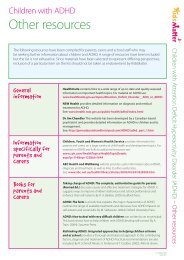
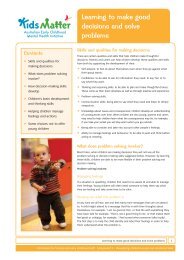
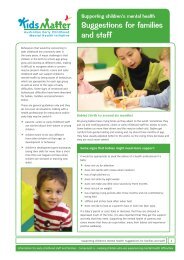
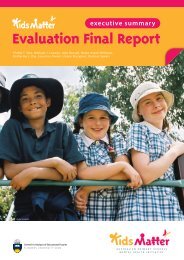

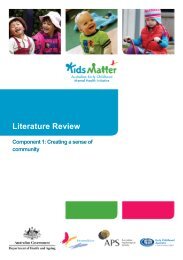
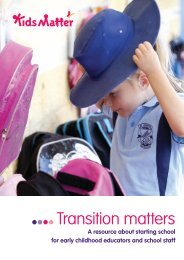
![Trinity Anglican School - Cairns story [378KB]pdf - KidsMatter](https://img.yumpu.com/41716076/1/184x260/trinity-anglican-school-cairns-story-378kbpdf-kidsmatter.jpg?quality=85)
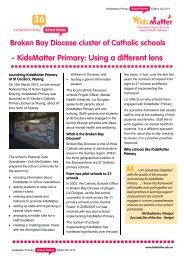
![Happy families work together [327KB] PDF - KidsMatter](https://img.yumpu.com/40767384/1/184x260/happy-families-work-together-327kb-pdf-kidsmatter.jpg?quality=85)
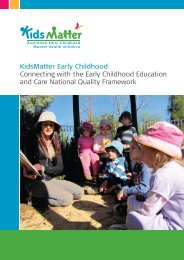
![Action Team Handbook 2012 [1.9M] [PDF] - KidsMatter](https://img.yumpu.com/38050920/1/184x260/action-team-handbook-2012-19m-pdf-kidsmatter.jpg?quality=85)
![[1008KB]pdf - KidsMatter](https://img.yumpu.com/38050895/1/184x260/1008kbpdf-kidsmatter.jpg?quality=85)
